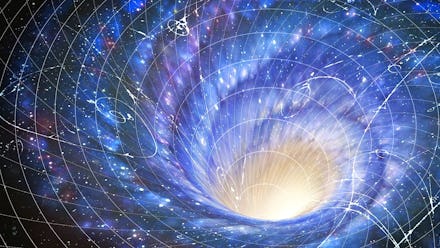Physicists Have New Proof That Backward Time Travel Is Impossible

Damn it, physicists, and your insistence on killing time travel theories.
Researchers confirmed the existence of a "pear-shaped" atomic nucleus — compared to most nuclei, which are disk-like, spherical or football-shaped — that might help us better understand the universe. Unfortunately, that understanding could be a real bummer for Back to the Future truthers.
All matter in the universe is comprised of atoms, each containing a nucleus. Until recently, scientists believed all those nuclei were symmetrical. That means the nuclei didn't "point" to a specific direction in space, or a related direction in time, so we couldn't prove backward time travel was out of the question.
But now, we can:
"We've found these nuclei literally point toward a direction in space," Marcus Scheck from the University of the West of Scotland, one of the study's researchers, told BBC News. "This relates to a direction in time, proving there's a well-defined direction in time and we will always travel from past to present."
Well, shit, Scheck.
The discovery came in 2013, when an international group of physicists, including Scheck, published a study in the journal Nature describing the pear-shaped nucleus of an atom called radium-224. The latest research, published in Physical Review Letters, confirms those original findings with a new atom, barium-144.
This isn't the first time the laws of physics have thrown a wrench into science fiction's real-life potential.
Take, for instance, the time-travel paradox that was recently introduced in season six of Game of Thrones. While the element of time travel ties storylines together, its physics don't exactly hold up: Wormholes are the closest working theory of actual time-travel that could explain Bran's ability to visit the past, but they're too volatile to be viable time-travel devices.
Even if wormholes were stable enough, you could only travel back to when the wormhole was created — not use it like an infinitely versatile, Doctor Who-ian shuttle bus. And that's assuming atomic nuclei don't point in the direction of time — and according to the new findings, some of them do.
And because Scheck apparently gets off on all of this, he and his team plan to run the experiment again — this time using the high-tech Isotope Separator On Line Detector lab at the European Organization for Nuclear Research. Because when physicists kill your dreams, they like to do it right.
Read more: